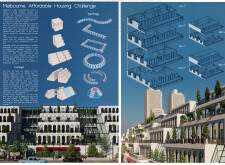5 key facts about this project
The design located in Melbourne addresses the need for affordable housing in a city with a diverse population and limited space. The main idea behind the design is to encourage community interaction and improve the quality of life through well-organized living spaces. By placing essential services within the residential setting, the design promotes daily connections among residents.
Community Integration
The approach focuses on bringing people together by placing services like stores, gyms, and kindergartens on the ground floor. This layout helps reduce travel time for residents and makes access to needed services easier. The arrangement supports an active community where people can engage in daily activities without venturing far from home.
Residential Typologies
Various housing types are included to meet the needs of different family sizes and demographics. This diversity allows for a community that feels inclusive. Each unit is designed with private outdoor spaces, such as yards for growing vegetables. These gardens contribute to sustainability and foster connections among residents, encouraging them to interact and collaborate.
Historical Context
The design takes cues from historic villages in Iran, like Masule, which used elevation effectively. By organizing homes vertically, the design addresses the challenge of limited land in Melbourne. This method helps free up ground space for community use and green areas, creating a livable environment that respects local traditions while addressing modern needs.
Climatic Considerations
Attention is also given to Melbourne's cold winters. By keeping the housing compact, the design reduces exposure to the elements, which improves energy efficiency and comfort. This careful consideration of climate plays a crucial role in ensuring that residents can enjoy warmth and shelter throughout the year.
At the heart of the design are communal areas such as courtyards and gardens, which function as social hubs. These spaces encourage residents to gather, fostering relationships and creating a sense of belonging within the community.



















































